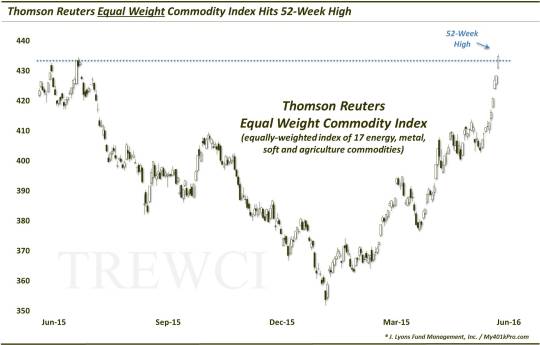Reflation Trade Has Been Broad-Based

An equally-weighted index of commodities just hit a 52-week high for the first time in more than 2 years.
One asset that has recently captured the rapt attention of market participants – or, at least the financial media – is oil. Most participants realize that the thousands of investable markets and securities don’t all hinge on every twitch in the price of oil. That said, there is no question about the importance of the commodity in terms of its influence on various markets as well as its impact in the economic and geopolitical realms. Thus, we can understand (sort of) the pseudo-obsession with the price of oil.
Naturally, one topic of discussion around oil prices centers on the question of whether or not the recent “reflation” trend is for real. That is, have the deflationary forces that have been in effect to a brutal degree over the past few years been put to rest? Or is the bounce in commodity prices this year, as impressive as it may be, merely a mean-reversion move?
Taking an oil-centric view of reflation reveals the imponderable nature of this debate. On the one hand, oil prices have bounced nearly 100% off of their February lows. That said, they have still retraced less than a third of their decline of the past 2 years. Furthermore, oil prices are still about 20% below their 52-week high, hit roughly a year ago. Thus, despite the impressive recent gains, characterizing the rally as “mean-reversion” or “counter-trend” is not out of the question.
If we broaden the reflation debate to commodities as a whole (which we should), we see some interesting findings. Looking at one of the most widely watched commodity indices, the Thomson Reuters/CoreCommodity CRB Index, or CRB, we see a similar story as oil. The CRB is up roughly 26% off of its February lows. However, it has recouped just a quarter of its post-2014 losses and is still 15% below its 52-week high. The similarity is not a surprise considering the composition of the CRB. Out of 19 commodities in the CRB, crude oil has a full 23% weighting of the index. Therefore, it naturally exerts a substantial influence on the behavior of the index.
Thomson Reuters offers another index that provides a different look at the state of the commodities market. The Thomson Reuters Equal Weight Commodity Index (TREWCI) consists of 17 commodities. But it weights each of them equally, so no one commodity exerts an undue influence on the performance of the index. Looking at the recent behavior of the TREWCI, we find an interesting development. Like the CRB, it is up about 25% off of its early-2016 lows. Significantly, the TREWCI has also retraced almost precisely 38.2% of its 2014-2016 decline, an important level in Fibonacci terms.
However, the most interesting recent development is the fact that, yesterday, the TREWCI scored its first 52-week high in over 2 years.

What this tells us is that the reflation trade has been quite broad-based, especially very recently. The emergence of grain prices in the past month have had a particularly positive effect. Considering the wide-ranging advances across the commodity markets, we are tempted to take the reflation trade more seriously as a durable phenomenon.
Of course, relative to the losses of the past 2 years, not to mention the past 5 or 8 years, the recent commodity rally still has much to prove. Furthermore, with the U.S. Dollar in a holding pattern over the past year, the currency has been able to work off much of its excesses built up during its preceding rally. Should this sideways action prove to be a continuation pattern, once the Dollar rally re-engages, it should certainly reapply pressure on commodity prices.
So while commodities have had a chance to make some hay during the Dollar weakness of the past 6 months, that tailwind may not last. Should it cease, it will become much clearer whether the reflation trade is durable or not. However, at this point, the obsession with oil prices has somewhat masked a quietly broad-based reflation rally across commodities in general.
_________
More from Dana Lyons, JLFMI and My401kPro.
The commentary included in this blog is provided for informational purposes only. It does not constitute a recommendation to invest in any specific investment product or service. Proper due diligence should be performed before investing in any investment vehicle. There is a risk of loss involved in all investments.